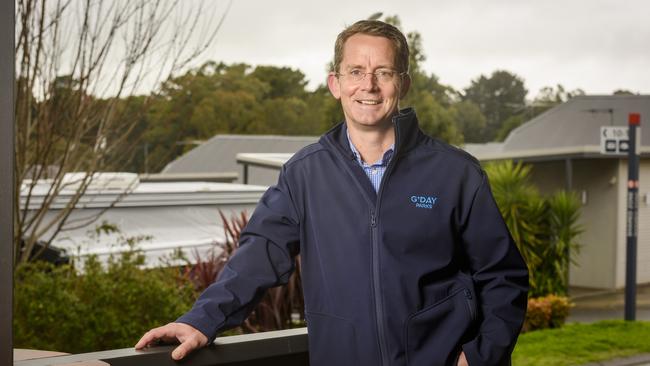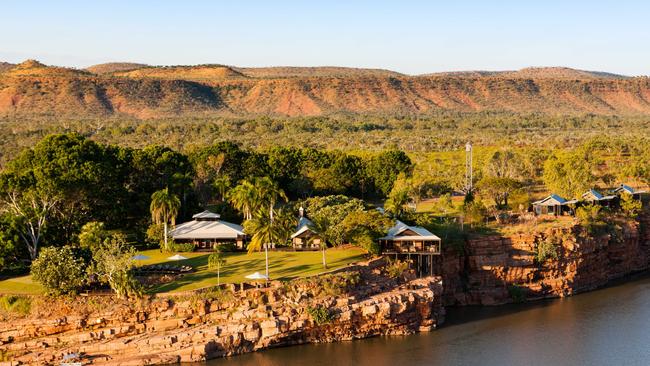G’Day Group plunges to loss but outlook remains bright
Floods have plunged the country’s largest regional accommodation provider into a multimillion-dollar loss, but it remains upbeat amid a domestic tourism boom.

Major flooding and weather events, and cost pressures including hikes in food, freight and wages, have plunged the country’s largest regional accommodation provider into a loss, but it remains upbeat amid a domestic tourism boom driven by budget-conscious Australians choosing to travel closer to home.
G’Day Group chief executive Grant Wilckens admits it’s been a tough year for his company, which runs more than 300 caravan and holiday parks and resorts across the country, hit by a series of major weather events stretching from the River Murray to the Kimberley.
According to financial statements lodged with ASIC, additions to the G’Day Group network helped boost full-year revenue by 28 per cent to $344.8m in the 12 months to June, but the company slipped to a net loss of $30.2m – down from a $38.4m profit in the previous year –due to impairments and disruption caused by the weather events.
A $26.7m impairment charge was largely down to the River Murray floods last summer, which affected seven of the company’s properties including at Nagambie, Echuca and Mildura in Victoria, and Moama in NSW.
While most of the sites are back up and running, or will be by Christmas, others are still being repaired and rebuilt, including the Buronga Riverside park in Mildura which will remain shuttered for another 12 months.
Meanwhile in Western Australia the collapse of the Fitzroy Crossing bridge in January has caused major disruption for travellers in the Kimberley, including at two of G’Day Group’s flagship resorts – El Questro and Lake Argyle.

A new bridge is expected to be completed in the new year following record-breaking floods that caused irreparable damage to the original structure, which was a vital transport link on the Great Northern Highway.
Mr Wilckens said the cost of repairs at flood-affected properties, and lost revenue at parks and resorts forced into temporary closure, had weighed heavily on the company over the past 12 months.
“The year’s been a challenging year. We’re clearly disappointed with what appears to be the results, but I think overall we’re actually pretty happy with where we’ve got to from a rebuild perspective,” he said.
“I’m also very bullish and optimistic about what lies ahead. We’ve still got very strong bookings in regional Australia, and certainly Christmas is upbeat and we’re upbeat about our forward bookings. We’re still getting very strong rates (tariffs) and very strong occupancy.”
G’Day Group includes the Discovery Parks network of more than 87 company-owned properties, as well as the G’Day Parks portfolio of 220-odd sites operated under a licensing arrangement.
The Adelaide-based company is backed by major shareholder Australian Retirement Trust, which holds a 95 per cent stake, with the rest owned by company management.
Diversification has underpinned its acquisition strategy in recent years, with the company adding luxury properties such as El Questro and Kings Canyon Resort in the Northern Territory to its caravaning and camping base.
Mr Wilckens, who established the company in 2004, said the company would continue to diversify its offering, with plans to spend more than $100m on acquisitions over the next 12 months and a further $150m on development of existing sites.
He said despite the surge in overseas travel in the aftermath of Covid-19, cost of living pressures continued to drive many Australians back to more affordable camp grounds and holiday parks.
“I’m glad I’m in the affordable or value part of the tourism and hospitality game because people trade down to holiday parks when everybody’s talking about cost of living, interest rates, fuel prices, energy and everything else,” he said.
“The caravan holiday park part of the industry is stronger than it’s been, there’s more caravans on the road, record sales of caravans, record investment in vehicles in terms of tow vehicles.
“The one shift that we have seen is powered sites have gone through the roof. There’s now 820,000 caravans on the road traveling around Australia – it’s a big number.”





To join the conversation, please log in. Don't have an account? Register
Join the conversation, you are commenting as Logout